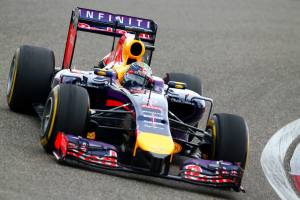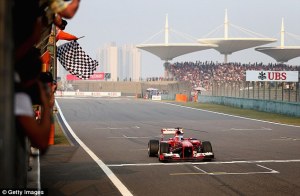The thrills and fireworks that we saw last time out in Bahrain were sadly lacking at the Chinese grand prix. In that respect the two races couldn’t have been more different, but in another they couldn’t have been more alike. Once again, we saw Mercedes very firmly on top yet again, as Lewis Hamilton led home his team-mate Nico Rosberg to take his first ever Formula 1 hat-trick of victories with his third straight win and the team’s third consecutive 1-2 finish.
The manner of Hamilton’s victory was akin to his first win of the season in Malaysia; completely dominant, with an 18 second margin of victory to his team-mate. In some ways, the race in Shanghai was even more impressive from Hamilton. The Englishman was severely hampered in Friday free practice because of suspension troubles which limited his running in FP1.
Despite finishing FP2 on top of the timesheets, Hamilton wasn’t happy with the car and made some big set-up changes for Saturday. Saturday free practice and qualifying were wet, however, which meant that, even though he claimed pole position, going into the race, however, he had no idea whether those changes would actually work. They clearly did, showing yet again that Hamilton’s detractors are wrong; he has the intellectual capacity to go alongside his undoubted natural speed and racing skills.
Indeed, the 2008 world drivers’ champion proved his critics wrong again during the race in China. Some said Hamilton would struggle with having to manage fuel consumption as a result of the 100 kg per hour fuel flow limit imposed in the new regulations. However, as we have seen in the previous two races, Hamilton’s fuel consumption was excellent. In China it was easily better than anyone else.
Hamilton has also been criticised for using his Pirelli tyres too aggressively in the past, resulting in higher wear rates and faster degradation than his rivals. In China, while the likes of Red Bull Racing’s four time world drivers’ champion Sebastian Vettel complained about tyre wear over the team-radio, Hamilton declared “Surprisingly the front tyres still feel really good, as well as the rears.” He pitted some three laps later than team-mate Nico Rosberg on lap 17, after a brief off track moment as his soft Pirelli tyres finally gave up.
Hamilton, as in Malaysia, led every lap of the race, but to be fair to Nico Rosberg things might have been closer than the 18 second margin of victory suggested. Rosberg had a poor start and fell backwards as his team-mate got the perfect launch off the line to lead Vettel into turn one. Rosberg on the other had dropped down to seventh place, after heavy contact with the Williams of Valtteri Bottas in turn one.
Rosberg did well to recover from his disastrous start, to finish the race in second place. This was even more the case given that the German – the race winner in Australia – had to race without his car’s telemetry being communicated to the pit wall. This meant that Rosberg had to provide his team with fuel consumption data from his steering wheel’s LED display – an annoyance and a clear source of frustration.
Rosberg’s troubles pale into insignificance compared to those of Sebastian Vettel, though. Vettel, so dominant in winning four consecutive championships wth Red Bull, is clearly struggling with the 2014 RB10 and the change of regulations. Vettel has been out qualified three times in four races by his new team-mate Daniel Ricciardo, and although he leads the young Australian in the fledging championship table he is not having things all his own way.
For the second time in two races, Vettel was asked to let the faster Ricciardo through. In China, he refused to do so, questioning his race engineer about the tyres the Ricciardo was on and the reason why he was being asked to move over. When told that Ricciardo had fresher tyres he replied simply “tough luck”. A couple of laps later Ricciardo moved ahead of his team-mate into turn one and although the official line from Red Bull was that Vettel had let him through, it certainly didn’t look like that was the case.
Vettel eventually finished the race in Shanghai a very distant fifth, only one place behind Ricciardo, but a massive twenty seconds adrift of his team-mate. Sobering stuff for the defending world drivers’ champion. He’s not the only one unexpectedly struggling, though. Kimi Raikkonen is having a torrid time on his return to Ferrari. The Finn finished down in eighth place in China, over 50 seconds behind his team-mate Fernando Alonso who drove brilliantly to claim Ferrari’s first podium of the season with a third place finish.
There are a few other teams and drivers that are worthy of a mention. Despite Romain Grosjean’s retirement following gearbox trouble it clearly looks like Lotus are finally getting their act together in 2014. The Frenchman did brilliantly to qualify in the top 10 and had been on course for a points finish before retiring. McLaren, though, seem to be on the opposite trajectory. After a hugely promising start to the season with a double podium finish in Australia, the Woking-based team now appear to be struggling. In China, they were the least competitive of all of the Mercedes powered teams, finishing in 11th and 13 positions, both cars having been lapped.
Williams are still looking competitive. But for first lap contact for both Felipe Massa and Valtteri Bottas and a truly horrendous first pit stop for Massa, the team might have had more than Bottas’s seventh place to take away from Shanghai. Given the right conditions, and a bit of luck, a podium finish would not look to be beyond Williams’s reach at some stage this season, especially if Massa can continue to make the same sort of lightning quick starts that we’ve seen in recent races.
It will be a big ask for anyone to catch Mercedes, though. Such was the dominance of Hamilton in Shanghai that the chequered flag was waved a lap early. A bizarre mistake, which fortunately didn’t alter the result of the race much. The only driver to miss out was Kamui Kobayashi in the Caterham, who had passed Jules Bianchi’s Marussia on the last scheduled lap of the race, which was officially classified as running for 54 laps rather than the planned 56, in accordance with the regulations.
Next we move to Europe for the Spanish grand prix. This is the race where traditionally the teams make big updates to their cars. On the strength of the evidence of the first four races, the others will have to make some massive improvements to get onto terms with the Silver Arrows.










